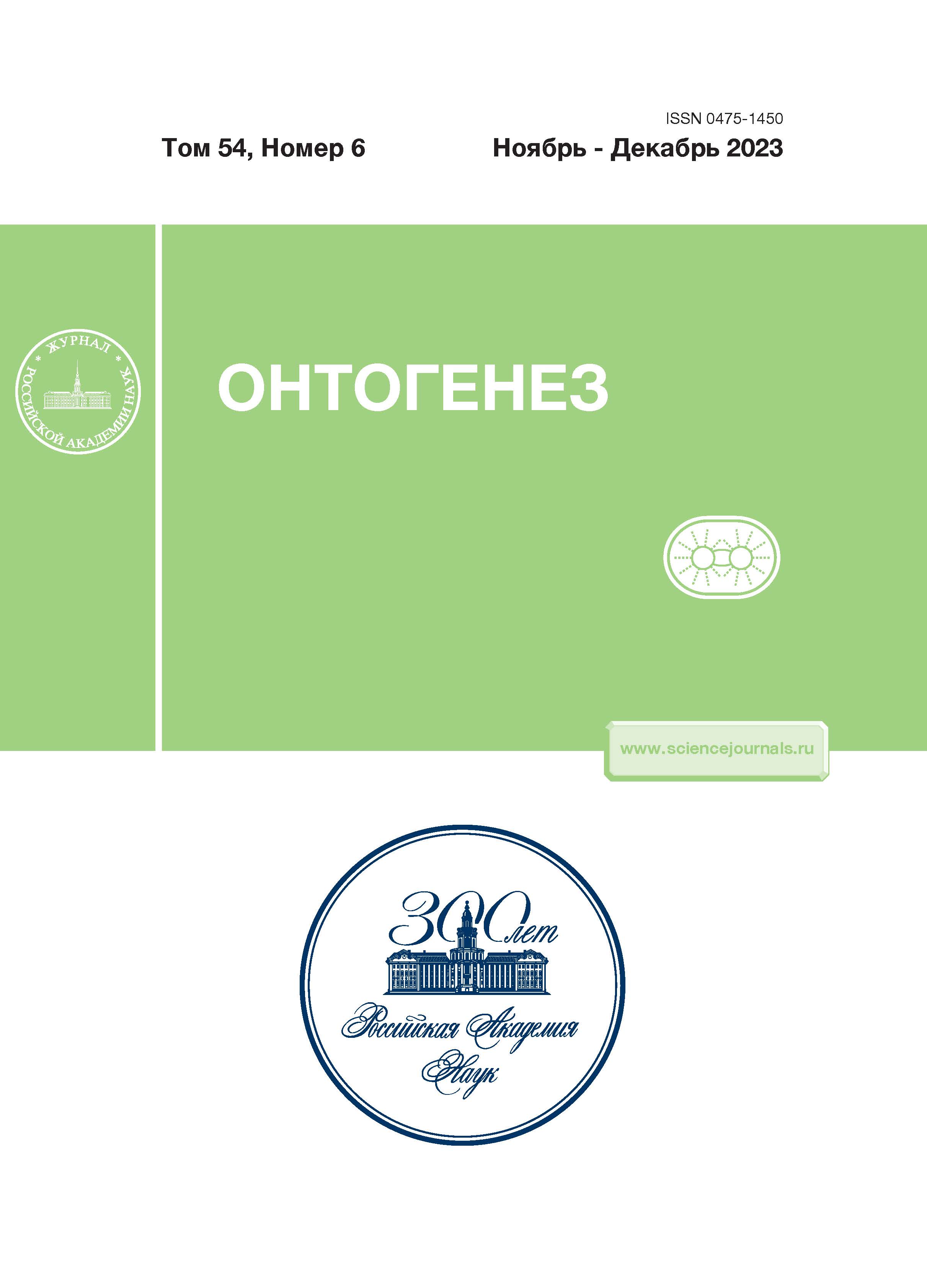Preliminary Exposure to Histone Deacetylase Inhibitors Changes the Direction of Human IPSCs Differentiation with the Formation of Cardiospheres Instead of Skin Organoids
- Авторлар: Abdyev V.K.1, Riabinin A.A.1, Erofeeva E.D.2, Pankratova M.D.1,2, Vorotelak E.A.1, Vasiliev A.V.1,2
-
Мекемелер:
- Koltsov Institute of Developmental Biology of Russian Academy of Sciences
- Lomonosov Moscow State University, Faculty of Biology
- Шығарылым: Том 54, № 6 (2023)
- Беттер: 389-396
- Бөлім: Short communications
- URL: https://cardiosomatics.ru/0475-1450/article/view/669911
- DOI: https://doi.org/10.31857/S0475145023060022
- EDN: https://elibrary.ru/HKRZYI
- ID: 669911
Дәйексөз келтіру
Аннотация
Pluripotent stem cells (PSCs) are a unique cell type that can differentiate into all cell types in the body. In PSC culture, subpopulations with different levels of pluripotency may exist, which leads to different results during their differentiation. One of the key factors that determine the state of pluripotency and influence the differentiation potential of PSCs is the epigenetic state of cells, including the level of histone deacetylation. Activation of histone deacetylase (HDAC) in human and mouse PSCs increases the percentage of heterochromatin. In this work, we used a protocol for the differentiation of embryoid bodies from induced human pluripotent hIPSC cells, designed for the formation of ectoderm and neuroectoderm with their subsequent development into skin organoids. However, after hIPSCs were exposed to HDAC inhibitors (sodium butyrate and valproic acid), the direction of their differentiation changed: mesoderm was formed, which subsequently developed into contracting cardiospheres.
Негізгі сөздер
Авторлар туралы
V. Abdyev
Koltsov Institute of Developmental Biology of Russian Academy of Sciences
Хат алмасуға жауапты Автор.
Email: mailtovepa@gmail.com
Russia, 119334, Moscow
A. Riabinin
Koltsov Institute of Developmental Biology of Russian Academy of Sciences
Хат алмасуға жауапты Автор.
Email: andrey951233@mail.ru
Russia, 119334, Moscow
E. Erofeeva
Lomonosov Moscow State University, Faculty of Biology
Email: andrey951233@mail.ru
Russia, 119234, Moscow
M. Pankratova
Koltsov Institute of Developmental Biology of Russian Academy of Sciences; Lomonosov Moscow State University, Faculty of Biology
Email: andrey951233@mail.ru
Russia, 119334, Moscow; Russia, 119234, Moscow
E. Vorotelak
Koltsov Institute of Developmental Biology of Russian Academy of Sciences
Email: andrey951233@mail.ru
Russia, 119334, Moscow
A. Vasiliev
Koltsov Institute of Developmental Biology of Russian Academy of Sciences; Lomonosov Moscow State University, Faculty of Biology
Email: andrey951233@mail.ru
Russia, 119334, Moscow; Russia, 119234, Moscow
Әдебиет тізімі
- Balafkan N., Mostafavi S., Schubert M. et al. A method for differentiating human induced pluripotent stem cells toward functional cardiomyocytes in 96-well microplates // Sci. Rep. 2020. V. 10. № 1. 18498. PMID: 33116175; PMCID: PMC7595118.https://doi.org/10.1038/s41598-020-73656-2
- Brons I., Smithers L.E., Trotter M.W.B. et al. Derivation of pluripotent epiblast stem cells from mammalian embryos // Nature. 2007. V. 448. № 7150. P. 191–195. https://doi.org/10.1038/nature05950
- Fischer B., Meier A., Dehne A. et al. A complete workflow for the differentiation and the dissociation of hiPSC-derived cardiospheres // Stem Cell Res. 2018. V. 32. P. 65–72. Epub 2018 Aug 24. PMID: 30218895. https://doi.org/10.1016/j.scr.2018.08.015
- Johnstone R.W. Histone-deacetylase inhibitors: novel drugs for the treatment of cancer // Nature. 2002. V. 1. № 4. P. 287–299. https://doi.org/10.1038/nrd772
- Lagarkova M.A., Eremeev A.V., Svetlakov A.V. et al. Human embryonic stem cell lines isolation, cultivation, and characterization // In Vitro Cell Dev. Biol. Anim. 2010. V. 46. № 3–4. P. 284–293. https://doi.org/10.1007/s11626-010-9282-6
- Lau K.X., Mason E.A., Kie J. et al. Unique properties of a subset of human pluripotent stem cells with high capacity for self-renewal // Nature Communications. 2020. V. 11. № 1. P. 1–18. https://doi.org/10.1038/s41467-020-16214-8
- Lee J., Koehler K.R. Skin organoids: A new human model for developmental and translational research // Exp. Dermatol. 2021. V. 30. № 4. P. 613–620. Epub 2021 Feb 18. PMID: 33507537; PMCID: PMC8265774.4).https://doi.org/10.1111/exd.14292
- Lee J., Rabbani C.C., Gao H. et al. Hair-bearing human skin generated entirely from pluripotent stem cells // Nature. 2020. V. 582. № 7812. P. 399–404.
- Saraiva N.Z., Oliveira C.S., Garcia J.M. Histone acetylation and its role in embryonic stem cell differentiation // World J. Stem. Cells. 2010. V. 2. № 6. P. 121–126. https://doi.org/10.4252/WJSC.V2.I6.121
- Seto E., Yoshida M. Erasers of histone acetylation: The histone deacetylase enzymes // Cold Spring Harb Perspect Biol. 2014. V. 6. № 4. a018713. https://doi.org/10.1101/CSHPERSPECT.A018713
- Shkumatov A., Baek K., Kong H. Matrix rigidity-modulated cardiovascular organoid formation from embryoid bodies // PLoS One. 2014. V. 14. № 9. 4 PMID: 24732893; PMCID: PMC3986240.https://doi.org/10.1371/journal.pone.0094764
- Takahashi K., Yamanaka S. Induction of pluripotent stem cells from mouse embryonic and adult fibroblast cultures by defined factors // Cell. 2006. V. 126. № 4. P. 663–676. https://doi.org/10.1016/j.cell.2006.07.024
- Teslaa T., Chaikovsky A.C., Lipchina I. et al. a-Ketoglutarate accelerates the initial differentiation of primed human pluripotent stem cells cell metabolism differentiation of primed human pluripotent stem cells // Cell Metabolism. 2016. V. 24. P. 485–493. https://doi.org/10.1016/j.cmet.2016.07.002
- Toyooka Y., Shimosato D., Murakami K. et al. Identification and characterization of subpopulations in undifferentiated ES cell culture // Development. 2008. V. 135. № 5. P. 909–918. https://doi.org/10.1242/DEV.017400
- Zhao M., Tang Y., Zhou Y., Zhang J. Deciphering role of wnt signalling in cardiac mesoderm and cardiomyocyte differentiation from human iPSCs: Four-dimensional control of Wnt pathway for hiPSC-CMs differentiation // Sci. Rep. 2019. V. 18. № 9. 1. PMID: 31852937; PMCID: PMC6920374.https://doi.org/10.1038/s41598-019-55620-x
Қосымша файлдар











